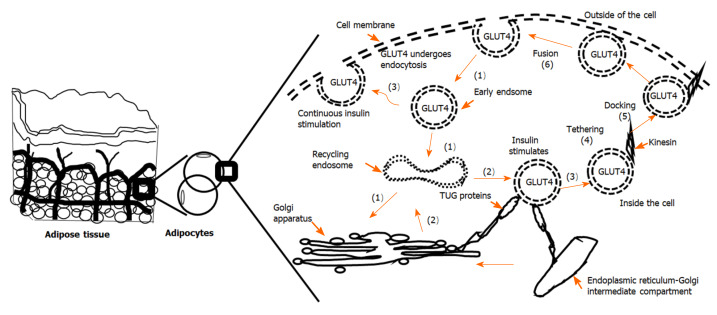Figure 2.
The movement of glucose transporter 4 in adipocytes. Adipose tissue is made of adipocytes. In adipocytes, glucose transporter 4 (GLUT4) can be found in the cell membrane and in the cytosol. The translocation of GLUT4 from cytosolic vesicles to the cell membrane leads to elevated glucose uptake, whereas endocytosis brings GLUT4 back to the cytosol. (1): In unstimulated cells, GLUT4 containing membrane portions are internalized in an endocytosis manner to generate vesicles containing GLUT4. GLUT4 vesicles are internalized into early (or sorted) endosomes. They can enter the recovery endoplasmic body, and follow the retrograde pathway to the trans-Golgi network and endoplasmic reticulum-Golgi intermediate compartment or other donor membrane compartments. (2): GLUT4 vesicles derived from the donor membrane structures are secured by tether containing a UBX domain for GLUT4 (TUG) protein. (3): During insulin signal stimulation, GLUT4 vesicles are released and loaded onto the microtubule motor to be transferred to the plasma membrane. The continuous presence of insulin leads to the direct movement of these vesicles to the plasma membrane. (4): GLUT4 vesicles are tethered to motor protein kinesin and other proteins. A stable ternary SNARE complex forms when this occurs. (5): The stable ternary SNARE complex is docked on the target membrane. (6): The docked vesicles rely on SNARE to move to and fuse with the target membrane[60,90,94]. GLUT4: Glucose transporter 4.

